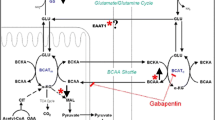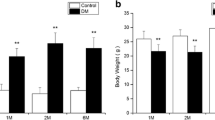Abstract
Diabetic retinopathy (DR) is the most common diabetic neurovascular complication, and the leading cause of preventable blindness among working-age individuals. Recently, agmatine, the endogenous decarboxylated L-arginine, has gained attention as a pleiotropic agent that modulates the diabetes-associated decline in quality of life, and exhibited varied protective biological effects. Diabetes was induced by a single streptozotocin (STZ, 50 mg/kg, i.p.) injection. When diabetes was verified, the animals were randomly allocated into three groups (16 rat each); diabetic, agmatine-treated diabetic (1 mg/kg, daily, for 12 weeks), and control group. Blood glucose homeostasis, retinal redox status, apoptotic parameters, nitric oxide synthase (NOS), nitric oxide (NO), vascular endothelial growth factor (VEGF), glutamate, glutamine, glutamine synthase (GS) activity, nuclear factor kappa-light-chain-enhancer of activated B cells (NFκB), and mitogen-activated protein kinase (MAPKs) pathways were assayed biochemically. Retinal vascular permeability was measured. Retinal morphology was evaluated by hematoxylin and eosin staining. Retinal N-methyl-D-aspartic acid receptor1 (NMDAR1) and glutamate aspartate transporter (GLAST) mRNA were quantified. Glucose transporter 1, pro-caspase3, and glial fibrillary acidic protein (GFAP) expression were quantified by immunohistochemistry. Chronic agmatine treatment abrogated STZ-induced retinal neurodegeneration features including gliosis, and neuronal apoptosis, restored retinal vascular permeability, mostly through antioxidant, anti-apoptotic capacity, abolishing glutamate excitotoxicity, modulating the activity of NMDARs, MAPKs/NFκB, and NOS/NO pathways. By restoring the molecular and functional background of retinal neurovascular homeostatic balance, agmatine would be appropriate therapeutic option acting upstream of the DR, impeding its progression.
Graphical abstract








Similar content being viewed by others
References
Abo El Gheit RE, Atef MM, Badawi GA, Elwan WM, Alshenawy HA, Emam MN (2020) Role of serine protease inhibitor, ulinastatin, in rat model of hepatic encephalopathy: aquaporin 4 molecular targeting and therapeutic implication. J Physiol Biochem 76(4):573–586. https://doi.org/10.1007/s13105-020-00762-0
Abo El Gheit RE, Atef MM, El Deeb OS, Badawi GA, Alshenawy HA, Elwan WM, Arakeep HM, Emam MN (2020) Unique novel role of adropin in a gastric ulcer in a rotenone-induced rat model of Parkinson’s disease. ACS Chem Neurosci 11(19):3077–3088
Abo El Gheit R, Emam MN (2016) Targeting heme oxygenase-1 in early diabetic nephropathy in streptozotocin-induced diabetic rats. Physiol Int 103(4):413–427
Akasaka N, Fujiwara S (2019) The therapeutic and nutraceutical potential of agmatine, and its enhanced production using Aspergillus oryzae. Amino Acids 52:181–197
Apak R, Güçlü K, Özyürek M, Çelik SE (2008) Mechanism of antioxidant capacity assays and the CUPRAC (cupric ion reducing antioxidant capacity) assay. Microchim Acta 160(4):413–419
Atef MM, Abd-Ellatif RN, Emam MN, Abo El Gheit RE, Amer AI, Hafez YM (2019) Therapeutic potential of sodium selenite in letrozole induced polycystic ovary syndrome rat model: targeting mitochondrial approach (selenium in PCOS). Arch Biochem Biophys 671:245–254
Atef MM, El-Deeb OS, Sadek MT, Abo El Gheit RE, Emam MN, Hafez YM, El-Esawy RO (2020) Targeting ERK/COX-2 signaling pathway in permethrin-induced testicular toxicity: a possible modulating effect of matrine. Mol Biol Rep 47(1):247–259
Barua S, Kim JY, Kim JY, Kim JH, Lee JE (2019) Therapeutic effect of agmatine on neurological disease: focus on ion channels and receptors. Neurochem Res 44(4):735–750. https://doi.org/10.1007/s11064-018-02712-1
Bredt DS, Schmidt HH (1996) The citrulline assay. In: Feelisch M, Stamler JS (eds) Methods in nitric oxide research. Wiley, New York, pp 249–270
Conti M, Morand PC, Levillain P, Lemonnier A (1991) Improved fluorometric determination of malonaldehyde. Clin Chem 37(7):1273–1275
Díaz-Coránguez M, Ramos C, Antonetti DA (2017) The inner blood-retinal barrier: cellular basis and development. Vis Res 139:123–137
Du Y, Tang J, Li G, Berti-Mattera L, Lee CA, Bartkowski D, Gale D, Monahan J, Niesman MR, Alton G, Kern TS (2010) Effects of p38 MAPK inhibition on early stages of diabetic retinopathy and sensory nerve function. Invest Ophthalmol Vis Sci 51(4):2158–2164
Fernandes R, Hosoya K, Pereira P (2011) Reactive oxygen species downregulate glucose transport system in retinal endothelial cells. American journal of physiology. Cell Physiol 300(4):C927–C936
Giove TJ, Deshpande MM, Gagen CS, Eldred WD (2009) Increased neuronal nitric oxide synthase activity in retinal neurons in early diabetic retinopathy. Mol Vis 15:2249–2258
Green LC, Wagner DA, Glogowski J, Skipper PL, Wishnok JS, Tannenbaum SR (1982) Analysis of nitrate, nitrite, and [15N] nitrate in biological fluids. Anal Biochem 126:131–138
Gu L, Xu H, Zhang C, Yang Q, Zhang L, Zhang J (2019) Time-dependent changes in hypoxia- and gliosis-related factors in experimental diabetic retinopathy. Eye (Lond) 33(4):600–609
Han N, Yu L, Song Z, Luo LY (2015) Agmatine protects Müller cells from high-concentration glucose-induced cell damage via N-methyl-D-aspartic acid receptor inhibition. Mol Med Rep 12(1):1098–1106
Hong S, Lee JE, Kim CY, Seong GJ (2007) Agmatine protects retinal ganglion cells from hypoxia-induced apoptosis in transformed rat retinal ganglion cell line. BMC Neurosci 8:81. https://doi.org/10.1186/1471-2202-8-81
Iizuka Y, Hong S, Kim CY, Yang WI, Lee JE, Seong GJ (2010) Protective mechanism of agmatine pretreatment on RGC-5 cells injured by oxidative stress. Braz J Med Biol Res 43(4):356–358
Jindal V (2015) Neurodegeneration as a primary change and role of neuroprotection in diabetic retinopathy. Mol Neurobiol 51(3):878–884
Jou SB, Liu IM, Cheng JT (2004) Activation of imidazoline receptor by agmatine to lower plasma glucose in streptozotocin-induced diabetic rats. Neurosci Lett 358(2):111–114
Kang S, Kim CH, Jung H, Kim E, Song HT, Lee JE (2017) Agmatine ameliorates type 2 diabetes induced-Alzheimer’s disease-like alterations in high-fat diet-fed mice via reactivation of blunted insulin signalling. Neuropharmacology 113:467–479
Kotil K, Kuscuoglu U, Kirali M, Uzun H, Akçetin M, Bilge T (2006) Investigation of the dose-dependent neuroprotective effects of agmatine in experimental spinal cord injury: a prospective randomized and placebo-control trial. J Neurosurg Spine 4(5):392–399
Kowluru RA, Engerman RL, Case GL, Kern TS (2001) Retinal glutamate in diabetes and effect of antioxidants. Neurochem Int 38(5):385–390
Kusari J, Zhou S, Padillo E, Clarke KG, Gil DW (2007) Effect of memantine on neuroretinal function and retinal vascular changes of streptozotocin-induced diabetic rats. Invest Ophthalmol Vis Sci 48(11):5152–5159
Liu IM, Cheng JT (2011) Mediation of endogenous β-endorphin in the plasma glucose-lowering action of herbal products observed in type 1-like diabetic rats. Evid Based Complement Alternat Med 2011:987876
Mahajan N, Arora P, Sandhir R (2019) Perturbed biochemical pathways and associated oxidative stress lead to vascular dysfunctions in diabetic retinopathy. Oxidative Med Cell Longev 2019:8458472
Moosavi M, Zarifkar AH, Farbood Y, Dianat M, Sarkaki A, Ghasemi R (2014) Agmatine protects against intracerebroventricular streptozotocin-induced water maze memory deficit, hippocampal apoptosis and Akt/GSK3β signaling disruption. Eur J Pharmacol 736:107–114
Ng YK, Zeng XX, Ling EA (2004) Expression of glutamate receptors and calcium-binding proteins in the retina of streptozotocin-induced diabetic rats. Brain Res 1018(20):66–72
Puro DG (2002) Diabetes-induced dysfunction of retinal Müller cells. Trans Am Ophthalmol Soc 43(9):3109–3116
Regunathan S, Piletz JE (2003) Regulation of inducible nitric oxide synthase and agmatine synthesis in macrophages and astrocytes. Ann N Y Acad Sci 1009:20–29
Rondón LJ, Farges MC, Davin N, Sion B, Privat AM, Vasson MP, Eschalier A, Courteix C (2018) L-Arginine supplementation prevents allodynia and hyperalgesia in painful diabetic neuropathic rats by normalizing plasma nitric oxide concentration and increasing plasma agmatine concentration. Eur J Nutr 57(7):2353–2363
Santiago AR, Hughes JM, Kamphuis W, Schlingemann RO, Ambrósio AF (2007) Diabetes changes ionotropic glutamate receptor subunit expression level in the human retina. Brain Res 1198:153–159
Semeraro F, Morescalchi F, Cancarini A, Russo A, Rezzola S, Costagliola C (2019) Diabetic retinopathy, a vascular and inflammatory disease: therapeutic implications. Diabetes Metab 5(6):517–527
Simó R, Stitt AW, Gardner TW (2018) Neurodegeneration in diabetic retinopathy: does it really matter? Diabetologia 61(9):1902–1912
Su CH, Liu IM, Chung HH, Cheng JT (2009) Activation of I2-imidazoline receptors by agmatine improved insulin sensitivity through two mechanisms in type-2 diabetic rats. Neurosci Lett 457(3):125–128
Waataja JJ, Peterson CD, Verma H, Goracke-Postle CJ, Séguéla P, Delpire E, Wilcox GL, Fairbanks CA (2019) Agmatine preferentially antagonizes GluN2B-containing N-methyl-d-aspartate receptors in spinal cord. J Neurophysiol 121(2):662–671
Wang B, Li PK, Ma JX, Chen D (2018) Therapeutic effects of a novel phenylphthalimide analog for corneal neovascularization and retinal vascular leakage. Invest Ophthalmol Vis Sci 59(8):3630–3642
Yu X, Xu Z, Mi M, Xu H, Zhu J, Wei N, Chen K, Zhang Q, Zeng K, Wang J, Chen F, Tang Y (2008) Dietary taurine supplementation ameliorates diabetic retinopathy via anti-excitotoxicity of glutamate in streptozotocin-induced Sprague-Dawley rats. Neurochem Res 33(3):500–507
Yu XH, Zhang H, Wang YH, Liu LJ, Teng Y, Liu P (2009) Time-dependent reduction of glutamine synthetase in retina of diabetic rats. Exp Eye Res 89(6):967–971
Zhong Q, Mishra M, Kowluru RA (2013) Transcription factor Nrf2-mediated antioxidant defense system in the development of diabetic retinopathy. Invest Ophthalmol Vis Sci 54(6):3941–3948
Funding
This work did not receive funding from any organizations.
Author information
Authors and Affiliations
Contributions
All authors contributed to research design, conception, data collection, and analysis interpretation, and shared in the critically revised process of the manuscript. Mervat H El-Saka and Nermin M Madi prepared the revised form of manuscript. All authors have approved the final manuscript version, submitted for journal publication and agree to be accountable for research aspects.
Corresponding author
Ethics declarations
Conflict of interest
The authors declare no competing interests.
Additional information
Publisher’s note
Springer Nature remains neutral with regard to jurisdictional claims in published maps and institutional affiliations.
Key points
• Agmatine effectively abrogated retinal microangiopathy and neurodegeneration in diabetic rats through modulation of NMDAR-mediated glutamate toxicity and Nrf2-mediated antioxidant capacity.
• Agmatine abrogated the NFκB/MAPK signal cascade, gliosis and restored the neurotransmitter balance, and the dysregulated neurovascular cross-talk in DR.
• Agmatine can be tooled as a neuromodulation-based therapeutic approach, to provide a safe and effective strategy for ameliorating DR.
Rights and permissions
About this article
Cite this article
Abo El Gheit, R.E., Soliman, N.A., Badawi, G.A. et al. Retinoprotective effect of agmatine in streptozotocin-induced diabetic rat model: avenues for vascular and neuronal protection. J Physiol Biochem 77, 305–320 (2021). https://doi.org/10.1007/s13105-021-00799-9
Received:
Accepted:
Published:
Issue Date:
DOI: https://doi.org/10.1007/s13105-021-00799-9




